
Dr. Cheong Kim is Senior Research Associate at the Idaho Policy Institute. He studies core areas of local government including service delivery/contracting, public budgeting/finance, cross-sectoral governance, and government-nonprofit relations. One of his research projects examined Idaho localities to learn how the for-profit or nonprofit sector affected government growth. Data analysis revealed for-profit or nonprofit sector size was inversely associated with government growth, consistent with theories about market or government failure. His papers are published in the Public Budgeting and Finance journal, International Journal of Public Administration, Social Science Journal, and Journal of Environmental Planning and Management. In his free time, Cheong enjoys hiking.

Dr. Matthew May is Senior Research Associate at the Idaho Policy Institute and School of Public Service Survey Director. His research interests include elections, electoral policy and the legislative process, with particular attention paid to the implications of Idaho’s recent shift to a closed primary system. He has extensive experience with survey design and quantitative analysis and during his time at IPI has worked on projects dealing with public policy in education, health and welfare, agricultural issues and public safety, among others. In his spare time, Matthew is an avid reader and enjoys writing, photography and baseball.

Dr. Vanessa Fry is Interim Director of the Idaho Policy Institute and Associate Research Professor in the Boise State School of Public Service. She has focused both her work and education on utilizing multi-sector, evidenced-based solutions to address persistent social, environmental, and economic issues and meet the current and critical needs in communities across Idaho and beyond. Dr. Fry is also an Adjunct Faculty Member at Presidio Graduate School in San Francisco where she received her MBA in Sustainable Management. In addition, Vanessa serves on the board of the Red Cross of Greater Idaho.
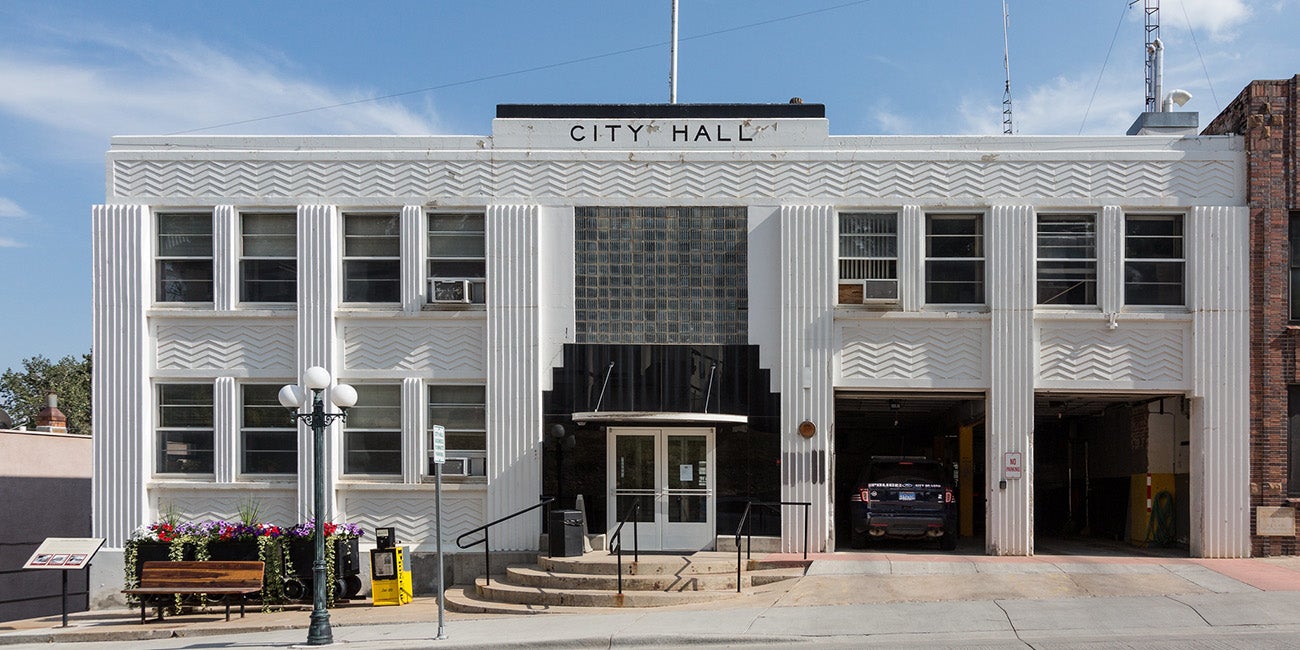
Since early 2020, the coronavirus (COVID-19) pandemic has produced a significant impact on every aspect of our lives, and municipal governments are no exception. The early days of the pandemic saw sweeping changes in the ways those governments conduct business, as emergencies were declared and in-person meetings gave way to virtual ones that allowed official responsibilities to be carried out while still following state or federal health distancing recommendations. Other actions soon followed.
Our team at the Idaho Policy Institute (IPI) recently surveyed cities and towns in 11 western states to find out what actions they took during the pandemic and how it turned out. Our findings indicate that many were quick to implement policy measures they considered necessary to mitigate the pandemic’s impact on their communities, but most encountered difficulties due to a lack of resources or absence of consensus among residents. The most successful policy measures were those that had buy-in from their communities.
The online survey of municipal governments was in the field for seven weeks, from October 20th to December 8th, 2020. IPI invited 1,867 municipalities in Arizona, California, Colorado, Idaho, Montana, Nevada, New Mexico, Oregon, Utah, Washington, and Wyoming to participate. Of these, 220 completed the survey, a response rate of 12%. Figure 1 breaks down responses by state.
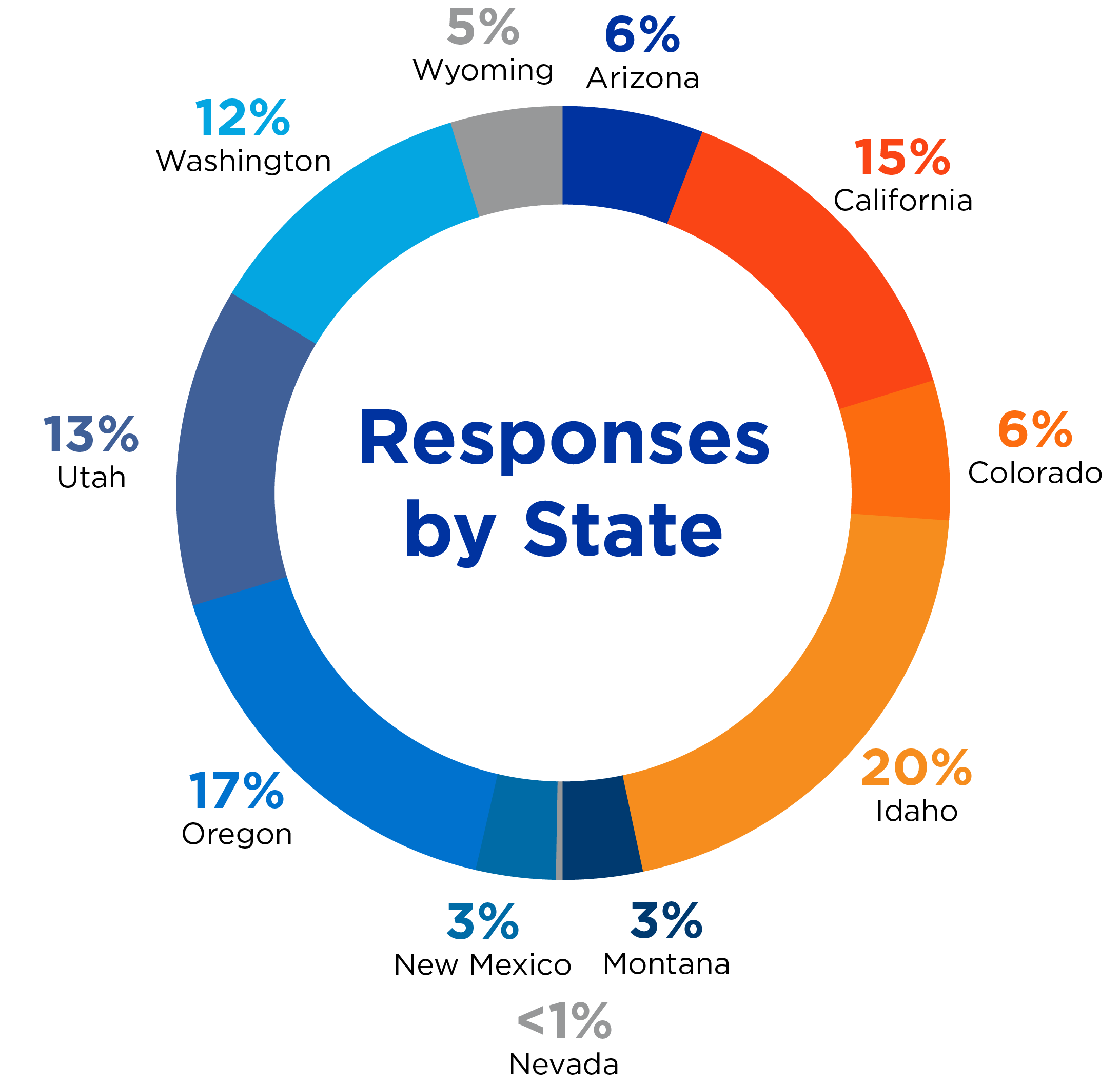
Types of Response
In the face of the COVID-19 pandemic, municipalities encountered numerous challenges, including statewide stay-at-home orders, social distancing guidelines, and uncertain economic conditions. By far the most common municipal response to the pandemic was a declaration of a state of emergency, with 159 (72%) indicating they had done so. Only 60 (27%) did not. Those that declared an emergency generally did so early in the pandemic, with the vast majority issuing the declaration in either March (104 municipalities, 75% of those who reported a month) or April (25, 18%). These municipal emergency declarations can be considered timely, as they accompanied the federal government’s national emergency declaration in mid-March.
Other widespread responses generally sought to transition government functions to remote environments in order to comply with social distancing recommendations while balancing the principles of transparent and open government. We asked municipalities to identify what policy measures they implemented by providing a list of potential measures they could select from, as well as an open-ended option they could fill out themselves. As they could select more than one measure, note that responses do not add to 100%.
The two most common policy measures that municipalities adopted were holding city/town council meetings online-only (172, 82%) and gathering information and sharing it with residents through information call centers, mailing lists, social media, and web pages (165, 79%). A little over half (120, 57%) indicated that they deferred collection of delinquent taxes, user fees, or service charges owed by residents, while 71 (34%) reported distributing essential personal products to residents, such as hand sanitizer, toilet paper, or masks.
Fewer municipalities than expected (71, 34%) issued social distancing orders, such as mandating business closures or that residents stay at home. All of the states included in our study had mandatory statewide stay-at-home orders in place by April 2020, so it could simply be the case that further action by a municipality was unnecessary. Alternatively, municipalities might have been hesitant to take action because stay-at-home orders, which often accompany mask wearing mandates, were highly contentious among residents. A small number of municipalities —28 (13%)—reported halting issuing citations or misdemeanors temporarily.
In addition to the six pre-listed policy measures, we were able to identify 10 additional measures from the open-ended responses of some municipalities. They included temporary closure of government facilities such as parks and libraries (16, 8%), assistance program for residents or businesses in need (9, 4%), mask wearing mandates (7, 3%), and remote working for government employees (6, 3%).
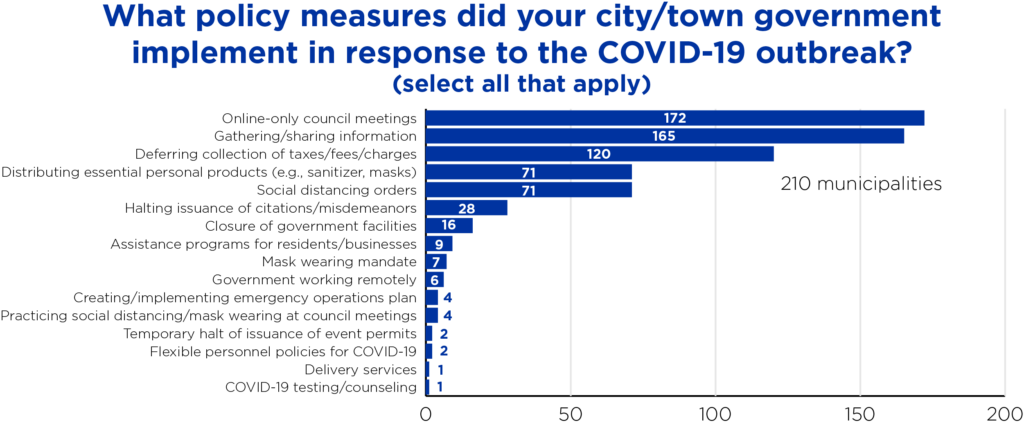
Timing of Measures
As important as what actions were taken is when those actions were taken. A total 213 municipalities specified the month they first implemented a policy in response to the pandemic, ranging from as early as February to as late as September. The distribution showed the same trend as emergency declarations, with a majority of cities and towns reporting first taking action in March (143, 67%) or April (51, 24%). Together these two months account for 91% of municipalities that took action. In short, most municipalities were swift to act.
This view is supported by their self-evaluation of the timeliness of their response, which we asked them to score on a scale of 1 to 7 (1=very late, 7=very timely). For categorization purposes, we grouped scores of 1 and 2 as “Late,” scores of 3, 4, and 5 as “Intermediate,” and scores of 6 and 7 as “Timely.” Out of 211 scores collected, most municipalities (74%) evaluated their implementation as overall timely, while 1% considered it late. About 25% felt their timeliness was somewhere in the middle.
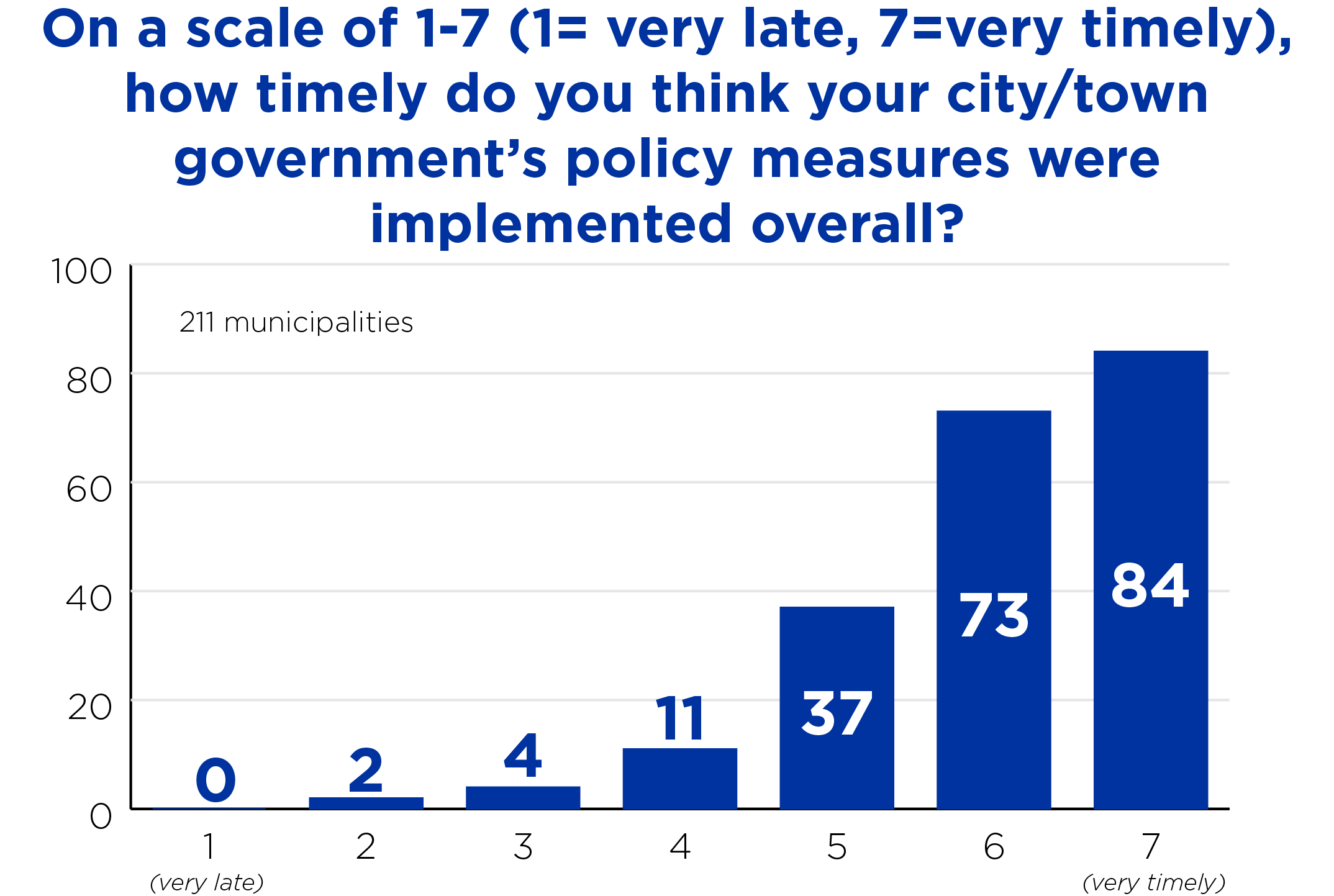
Effectiveness of Measures
While municipalities generally gave themselves high marks on their timeliness, they were less certain in their self-evaluation of the overall effectiveness of their COVID-19 measures. We asked them to score the effectiveness of their measures on a scale of 1 to 7 (1=very ineffective, 7=very effective). Once again, we grouped scores of 1 and 2 as “Ineffective,” scores of 3, 4, and 5 as “Moderately effective,” and scores of 6 and 7 as “Effective.”
Of the 194 scores collected, most (56%) felt their measures overall were effective, while 42% felt they were only moderately effective. About 2% felt their measures were not very effective (scoring 1 or 2). Considering timeliness and effectiveness scores together, while both produced positive self-evaluation ratings, it is interesting that the overall positive percentage share for effectiveness (56%) was 18 percentage points less than the positive percentage share for timeliness (74%). This may imply that municipalities felt that, despite fast action, their policy measures were not effective enough.
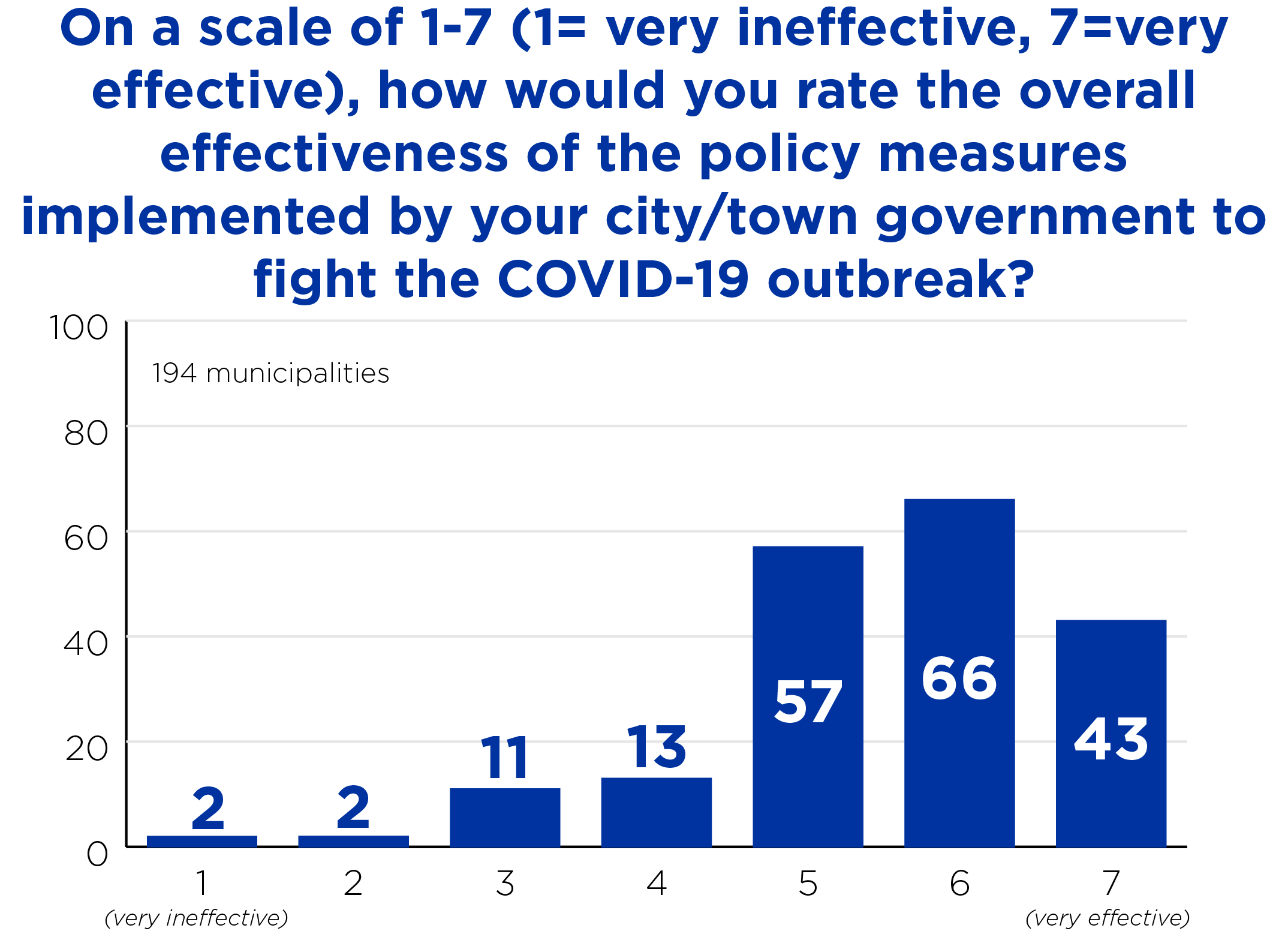
Common Barriers to Success
So, what kept measures from being successful? We asked municipalities to choose from a list that included an open-ended option the barriers they encountered trying to achieve their COVID-related policy goals.
While no single barrier exceeded the 50% threshold, the most frequently indicated response was a lack of support from residents (87, 45%), followed closely by conflicts among residents (80, 41%), lack of support from county, state or federal government (77, 40%), and lack of fiscal or human resources (71, 37%). Interestingly, we note that the top two barriers are generally associated with citizen buy-in and cooperation, followed by the availability of government resources or support from higher levels of government.
There was a substantial drop-off from the number of municipalities encountering these barriers and others, including lobbying of interest groups (17, 9%), administrative rules, regulations, and procedures in their government (15, 8%), conflicts among administrative units (14, 7%), delayed decision by their legislative council (14, 7%), and lack of support from the council (12, 6%).
In addition to the nine pre-listed barriers, we identified three additional barriers from open-ended responses: lack of reliable science or information on COVID-19 (5, 3%), the virus itself (2, 1%), and lack of cooperation from visitors (1, 1%).
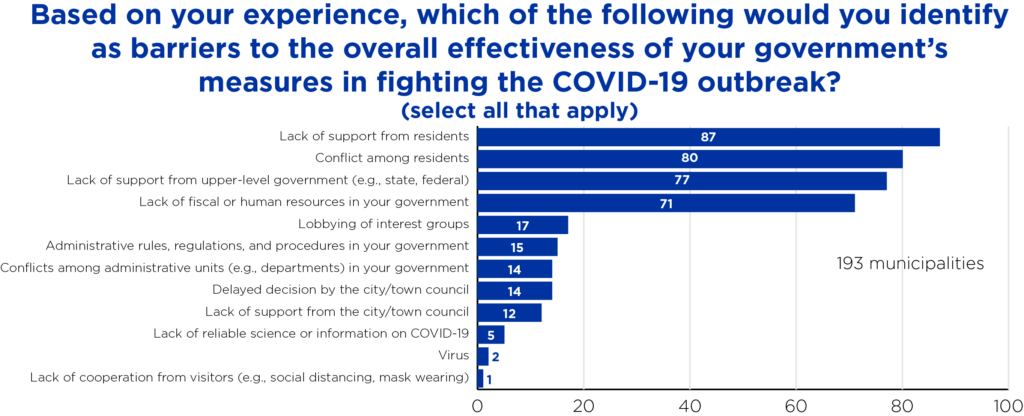
Overall, these findings suggest resources and collaboration with stakeholders is indispensable for a municipality to help mitigate the impact of the pandemic. For example, the success of a social distancing order depends on resident support or active coordination with other governments (county, state, or neighboring municipality).
Unsurprisingly, given these results, when asked to identify essential partners in ensuring the effectiveness of their COVID-19 policies, municipalities overwhelmingly said residents (172, 79%) were the most essential partner. This was closely followed by both the state government (163, 74%) and other local governments (144, 66%), potentially underscoring the interconnected nature of state and local governments in these states. The federal government (90, 41%), nonprofit organizations (78, 36%), and private companies (70, 32%) rounded out the list, although none of these three exceeded 50% of responses. COVID-19 testing or vaccination requires help from local clinics (nonprofits) or pharmacies (private companies).
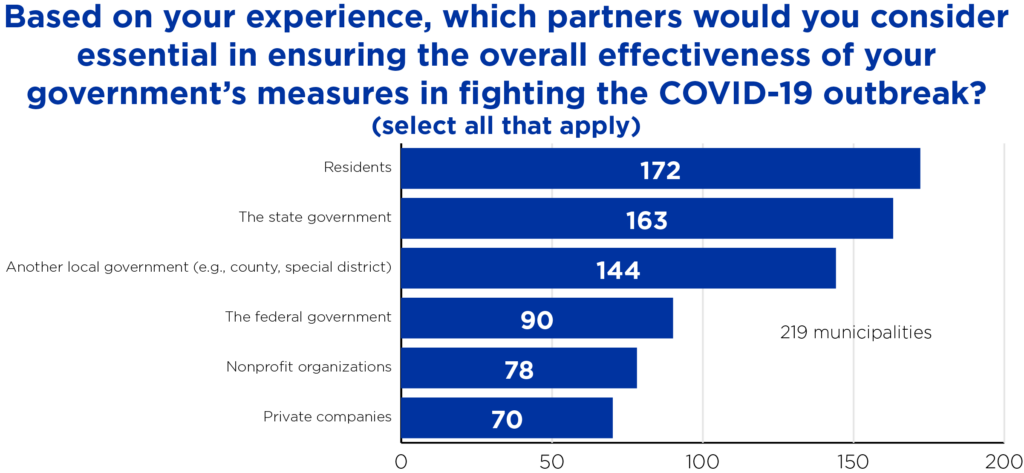
When asked about the most significant barrier to collaboration with their partners, about half of the municipalities indicated a difference in political orientation between them and their partners (80, or 51%), followed by lack of trust with the partners (49, 31%). This, along with earlier findings concerning resident buy-in, is perhaps indicative of how much successful collaboration depends on building trust with all stakeholders, and that it can be particularly difficult to do so along partisan lines.
Additional barriers included autonomy-related concerns held by municipalities (33, 21%) or their partners (36, 23%), followed by a concern that partners would not honor commitments (24, 15%) and lack of interest from their own council (19, 12%). Besides the six pre-listed barriers, we identified 12 extra barriers from the open-ended responses of some municipalities, which included lack of information or communication (7, 4%), lack of leadership (7, 4%), and lack of resources (3, 2%).

Looking Ahead
With the ongoing development and distribution of COVID-19 vaccines and treatments, there is hope that the pandemic will end in the near future. Where do municipal governments go from here? Looking forward to the post-pandemic era, an open question is whether the pandemic will produce any lasting changes among governments, or if their actions were more temporary and situation-based. We asked each municipality to indicate their level of agreement with the following statement: The COVID-19 outbreak will cause a substantial change in the behavior of city/town government after the outbreak has ended. We asked them to indicate their level of agreement using a 7-point scale (1=strongly disagree, 7=strongly agree). Surprisingly, most municipalities expressed uncertainty with how lasting an impact the pandemic will have, with 46% scoring their agreement somewhere in the middle (scoring 3-5). Fewer (37%) indicated that it will produce lasting changes in municipal governments (scoring 6 or 7), while 17% said it would produce no lasting change (scoring 1 or 2).
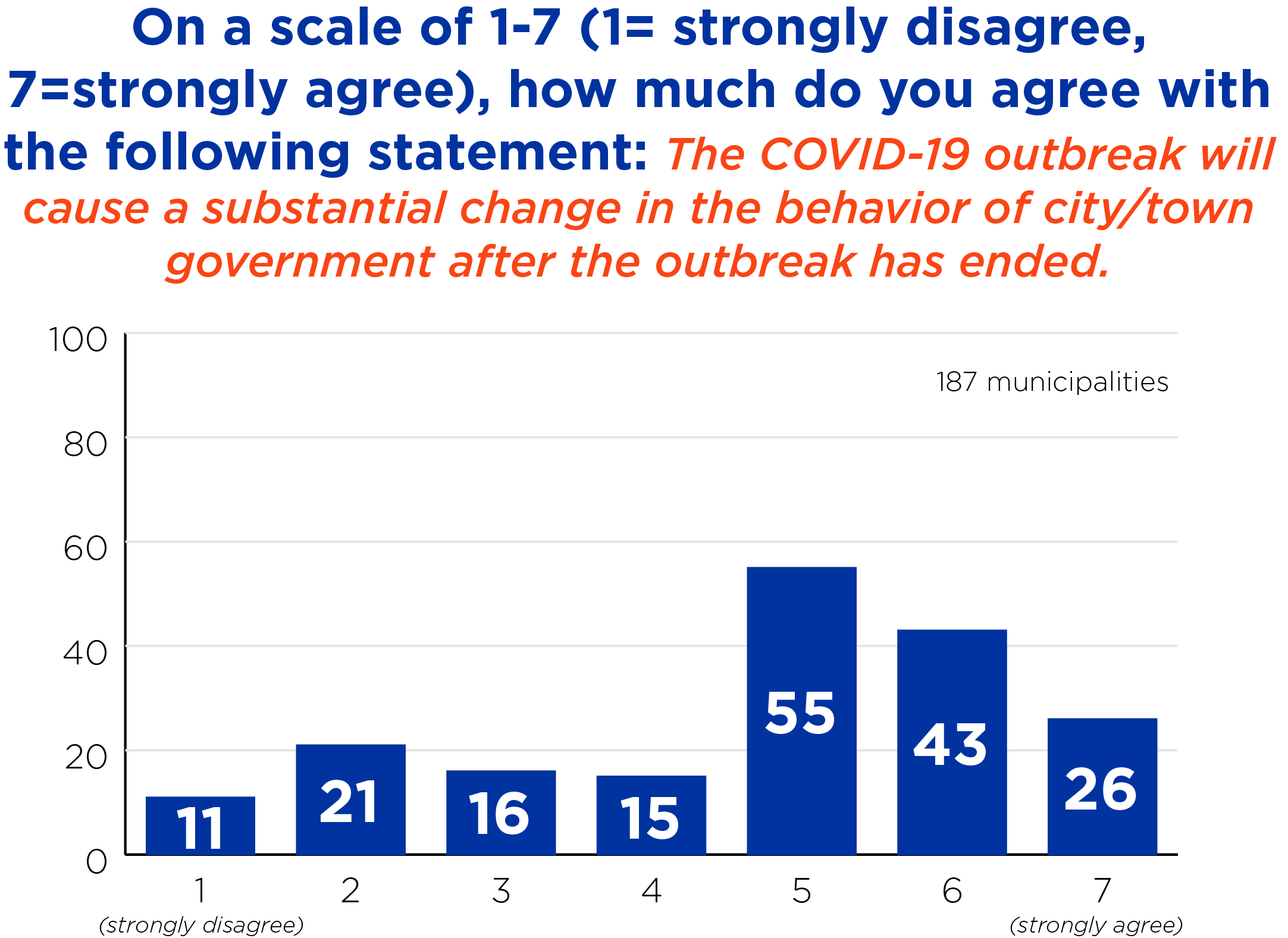
Municipalities expect the most likely lasting impact from the pandemic is an increased online presence for municipal governments (172, 79%) – for example, accepting fee payments online, sharing more information online, streaming council meetings and public hearings, or facilitating municipal elections online. This is distantly followed by the creation of or update to an existing government-wide plan for disaster management (97, 44%) and governments stocking basic supplies like canned food, masks, gloves, and so-on (87, 40%).
A small proportion of municipalities expect an increase in the amount of annual savings in government fiscal reserves (34, 16%), while slightly more (38, 17%) predict no substantial changes. Apart from the five pre-listed responses, we further identified six from the open-ended responses. Among them, remote working of government employees (7, 3%) is noticeable.
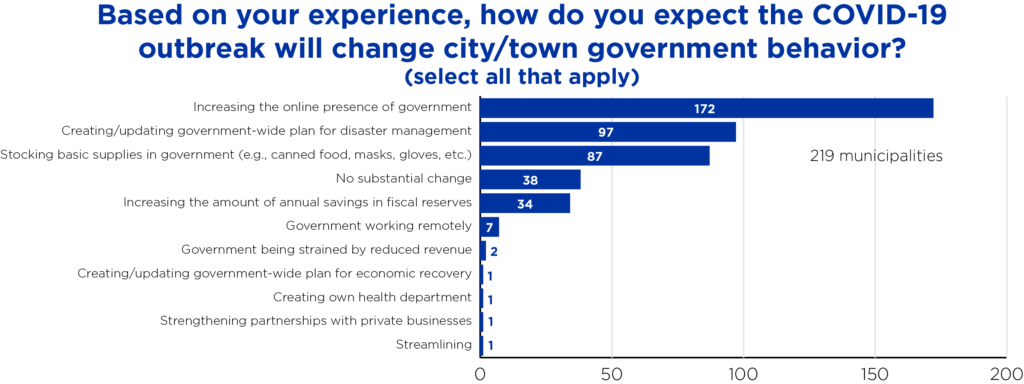
The COVID-19 pandemic has presented numerous challenges for municipal governments. It has required adapting to rapidly changing circumstances and new policy approaches to meet the growing demands placed upon those governments, while also orienting them to be more responsive in the future. Our findings identified not only the actions taken by municipalities in response to the pandemic, but the lessons learned from the experience.
Most municipalities acted early upon the pandemic, issuing emergency declarations and implementing various policy measures to help mitigate its effects. In contrast with their swiftness in action, they reported relatively low levels of effectiveness. Many reported difficulties achieving buy-in from their communities, underscoring the importance of obtaining support from residents to achieve greater effectiveness. Our research suggests successful implementation of policies cannot be done by an individual government entity alone. Rather, it often requires collaboration among major stakeholders such as residents, neighboring municipalities, or states, even under emergency situations like the COVID-19 pandemic. Further, our research suggests that collaboration is best accomplished when trust is built to help overcome differing political views.